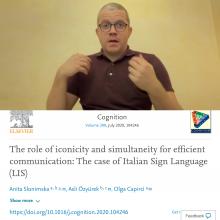Journal “Cognition” publishes a paper on iconicity, simultaneity, and Italian Sign Language, by Anita Slonimska, Asli Özyürek and Olga Capirci.

Slonimska, A., Özyürek, A., Capirci, O. (2020) The role of iconicity and simultaneity for efficient communication: The case of Italian Sign Language (LIS), Cognition. 2020;200:104246.
https://doi.org/10.1016/j.cognition.2020.104246
Abstract
A fundamental assumption about language is that, regardless of language modality, it faces the linearization problem, i.e., an event that occurs simultaneously in the world has to be split in language to be organized on a temporal scale.
However, the visual modality of signed languages allows its users not only to express meaning in a linear manner but also to use iconicity and multiple articulators together to encode information simultaneously.
Accordingly, in cases when it is necessary to encode informatively rich events, signers can take advantage of simultaneous encoding in order to represent information about different referents and their actions simultaneously. This in turn would lead to more iconic and direct representation.
Up to now, there has been no experimental study focusing on simultaneous encoding of information in signed languages and its possible advantage for efficient communication.
In the present study, we assessed how many information units can be encoded simultaneously in Italian Sign Language (LIS) and whether the amount of simultaneously encoded information varies based on the amount of information that is required to be expressed.
Twenty-three deaf adults participated in a director-matcher game in which they described 30 images of events that varied in amount of information they contained. Results revealed that as the information that had to be encoded increased, signers also increased use of multiple articulators to encode different information (i.e., kinematic simultaneity) and density of simultaneously encoded information in their production.
Present findings show how the fundamental properties of signed languages, i.e., iconicity and simultaneity, are used for the purpose of efficient information encoding in Italian Sign Language (LIS).

